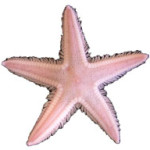
Homarus americanus
Because they belong to the invertebrate phylum Arthropoda (see our Help pages for an explanation of taxonomic classification), lobsters are actually closely related to insects.
This relationship arises because of two main characteristics that they share: they all have an exoskeleton (outer skeleton) and they all have joint appendages. Lobsters are farther categorized into the class Crustacea, along with other marine organisms like crabs and shrimp. These crustaceans are distinguishable from other Arthropods with hard exoskeletons, like mussels and clams, because their shell is softer and more flexible. As lobsters have ten legs they also belong to the order Decapoda (derived from the Latin word, ten feet).
The American lobster (Homarus americanus), also known as the Northern or Maine lobster, belongs to the family Nephropidae. Another kind of edible lobster found in the order Decapoda is the spiny or rock lobsters of the family Palinuridae. They differ from the American lobster in that they lack large claws, have spines all over their bodies, and are found in warmer subtropical and tropical waters..
The American lobster is found in the northwest Atlantic from Labrador to Cape Hatteras, North Carolina, from the inter-tidal to 480 metres, but is most common from four to fifty metres. Lobsters prefer to make their homes in rocky areas where they can hide in the crevices from predators. The biggest predator of the American lobster is man, followed by ground fish such as flounder and cod, sculpins, eels, rock gunnels, crabs, and seals.
Lobsters are not fussy eaters. Although they prefer fresh food they will eat basically anything that they can get their claws on, even if it’s dead. (Which is why lobster traps are so effective). The main diet of a lobster is crab, mussels, clams, starfish, sea urchins and various marine worms. They are also known to catch fast moving animals like shrimp, amphipods (also known as “sand fleas”) and even small fish.
Lobsters eat mostly animals, but if these resources become scarce, as they sometimes can be in the spring, they might feed on plants, or sponges to get energy. In the Northumberland Strait, an area making up a great part of the southern Gulf of St. Lawrence, a main dish for a lobster in the winter (fall) is a newly settled crab. Lobsters in this area can get up to half of their energy requirements from crabs.







Social Profiles